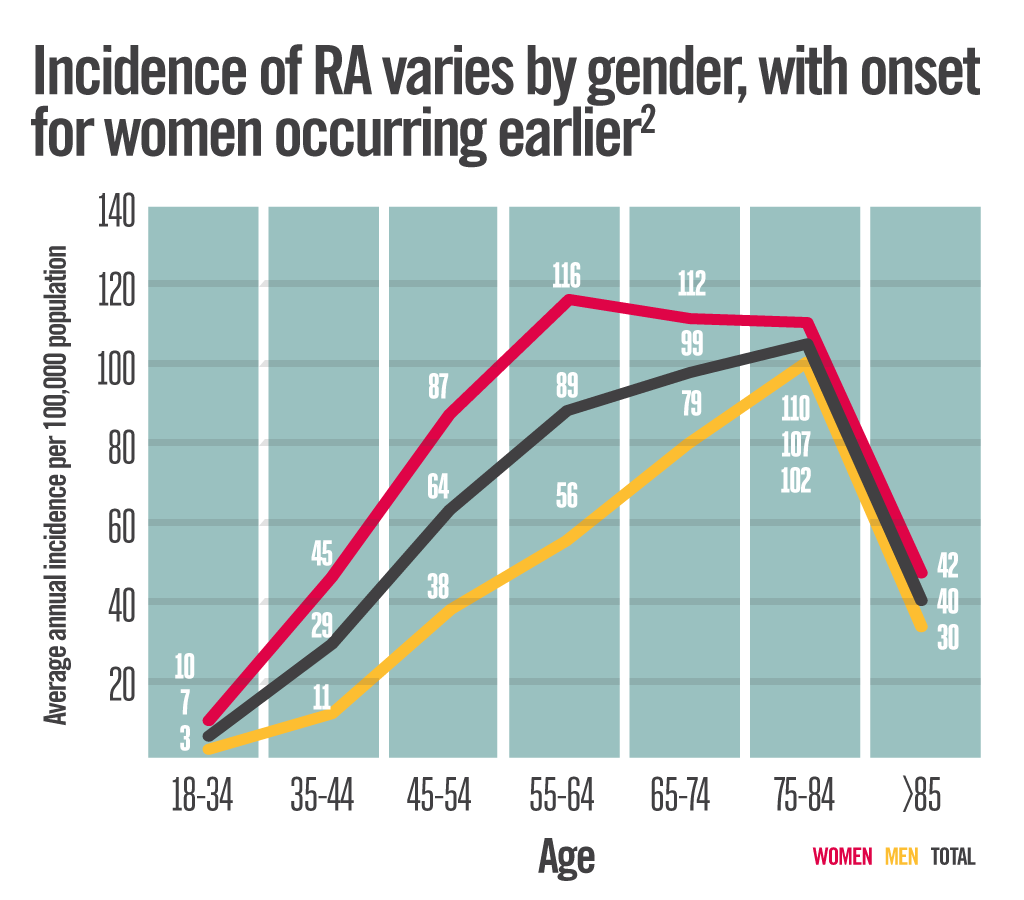RA and Women’s Health
Reviewed by: HU Medical Review Board | Last reviewed: September 2013. | Last updated: November 2022
When it comes to RA, gender really makes a difference. Of the 1.3 million adults in the US who suffer from RA, the majority are women. The prevalence of RA among women is approximately double that in men.1
Differences between women and men with RA
The course of RA also differs between women and men, with the onset of the disease typically occurring much earlier for women, for many, during their 30s and 40s. In one study conducted in the US, the incidence peaked earlier for women than men, at about ages 55 to 64 years for women, compared with 75 to 84 years for men. Rates of RA increased dramatically for women during the third and fourth decades of life.2

Effects many women during the childbearing years
Because RA is diagnosed in many women during their 30s and 40s, the disease tends to have an impact on a woman during a time in life when there is the heaviest burden in terms of childbearing, raising children, and work in and out of the home. One large international study found that RA had a more pronounced negative impact on both body and psyche in women compared with men, as seen in scores for quality of life, disease activity, and pain.3,4
Role of sex hormones in autoimmune response
One hypothesis for why RA and other autoimmune disorders (such as Multiple Sclerosis and lupus) disproportionately affect women is that the female and male immune systems operate differently due to the varying effects of sex hormones (estrogens, progesterone, and testosterone). Immune activities may be enhanced when there are low levels of these hormones and inhibited when there are higher levels, such as during pregnancy.5
This correlates with observations that during pregnancy (when hormone levels are high), symptoms of RA appear to improve. In women, there are natural fluctuations in levels of hormones that occur during the menstrual cycle, as well as during pregnancy. Changes in hormone levels may also be affected by oral contraceptive medications and estrogen replacement therapy. It has been observed that the symptoms of RA may worsen before a menstrual period and change during the menstrual cycle. During the nine months of pregnancy, when levels of hormones are high, RA symptoms may decrease, returning to pre-pregnancy norms after birth.5
Pregnancy and RA
Many changes occur in the immune system during pregnancy, partly in response to changes in hormone levels. Because RA affects many women during their childbearing years, the effect of RA and treatments for RA on pregnancy can be of concern. About 50% to 60% of women with RA may experience an improvement in symptoms during pregnancy, beginning during the first trimester and continuing through delivery. This is fortunate, because most drugs used to treat RA may cause problems with the normal development of a fetus.6 When planning to become pregnant, men and women diagnosed with RA must cease taking some commonly prescribed medications, such as methotrexate, for at least 3 months before attempting pregnancy. It is important to consistently use an effective form of birth control when taking some RA treatments to prevent an unplanned pregnancy. Talk to your doctor about how your treatment plan affects family planning.
Benefit of RA treatment and lifestyle modifications
Because RA can affect women in the prime of life when they are juggling many responsibilities, including work, home, and child-raising, it is particularly important for women to make sure that they are taking advantage of all the tools available to them to assist with daily living. These include effective RA drug treatments, which can slow or reduce damage to joints and other structures, and lifestyle modifications to insure regular sleep, nutrition, exercise, and steps to control risk for diseases, including osteoporosis and heart disease. Because bone loss, in particular, is a complication that often occurs with RA, it is important for a woman to get appropriate levels of calcium and to monitor bone health with regular bone density testing.
Exercise and women's health
Maintaining a schedule of regular exercise is particularly important for a woman with RA. A program of gentle exercise, including strength training, aerobic activity, and stretching can help minimize joint pain. Additionally, exercise can help minimize bone loss that may result from chronic corticosteroid treatment, which is often used to control acute inflammation associated with RA. Exercise has been shown to provide a range of benefits, not limited to joint and musculoskeletal health. A regular program of exercise can help protect against a range of health conditions, from heart disease to diabetes, obesity, and can help decrease stress and improve mood. These latter benefits are particularly important because the challenges associated with RA can be a source of stress and increase the risk of depression and other mood disorders.
A range of physical or mental disciplines may provide benefits in terms of stress and mood, including yoga, meditation, tai chi, guided imagery, or acupuncture. Some of these may also help with common RA symptoms, including fatigue and pain.